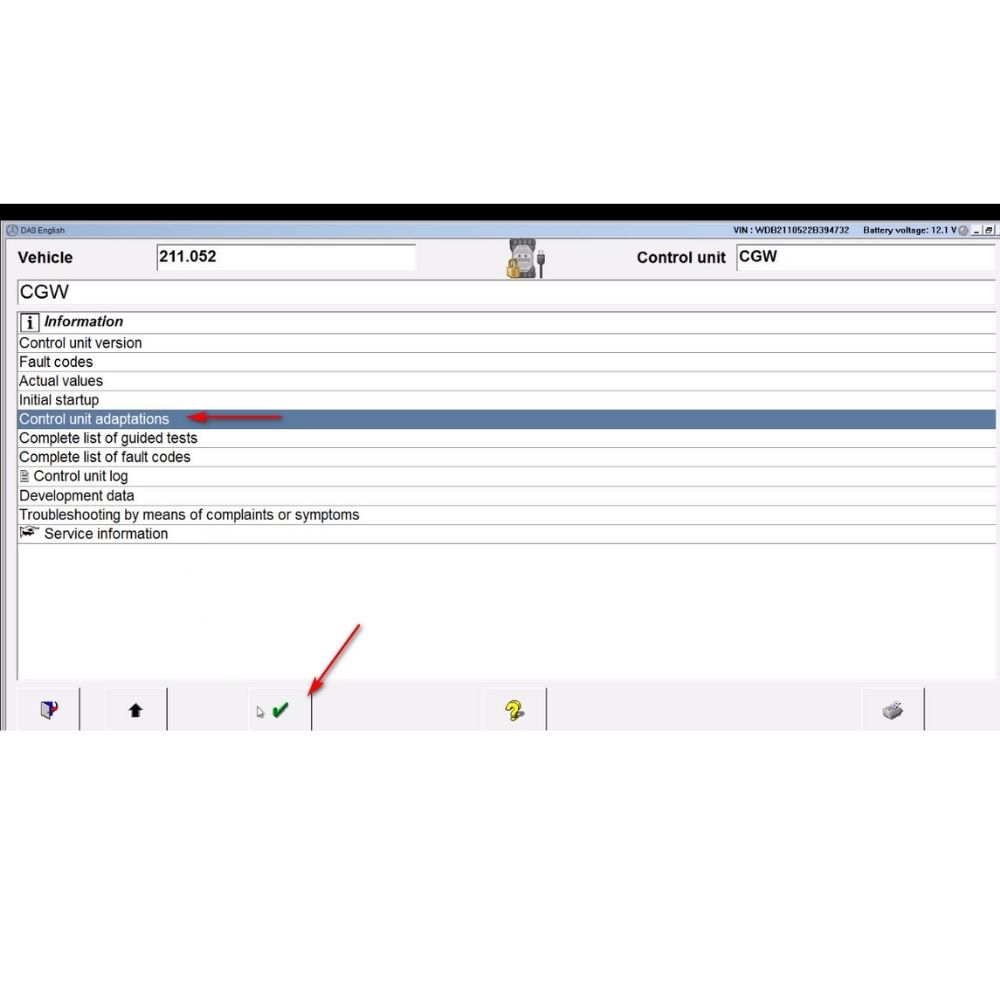
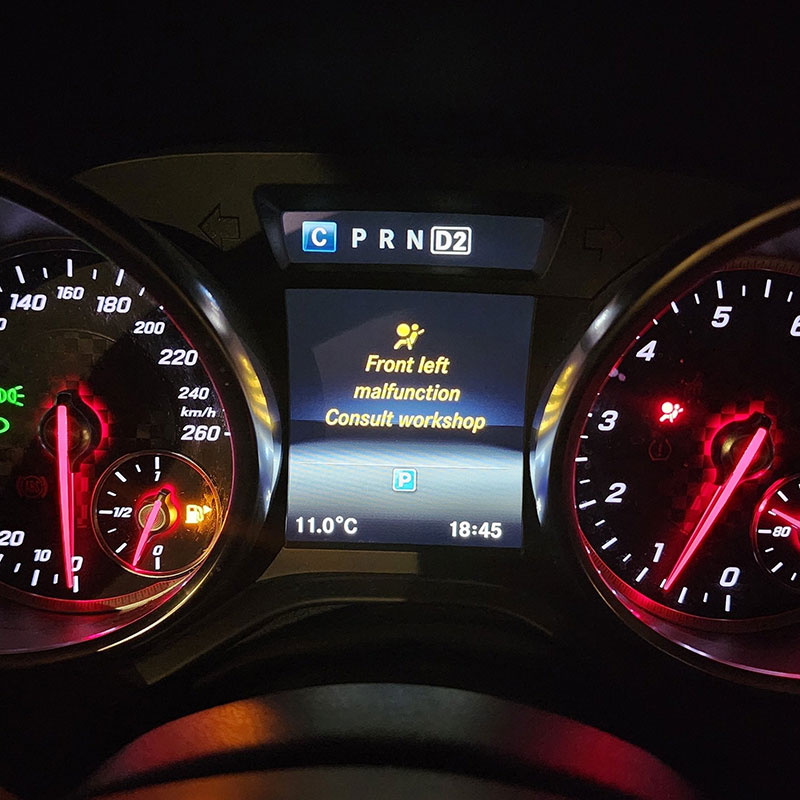
The fault code B1616 in Mercedes-Benz vehicles relates to an issue with the Supplemental Restraint System (SRS) Electronic Control Unit (ECU). Specifically, it indicates a safing G-sensor electronic circuit failure. The safing G-sensor works alongside primary crash sensors to verify collision severity before airbag deployment, ensuring airbags only deploy when necessary.
Table of Contents
ToggleWhen your Mercedes-Benz detects a B1616 Mercedes warning light code, it will communicate this issue through several noticeable symptoms. Being aware of these signs will allow for timely diagnosis and repair, ensuring the continued functionality of your SRS.
Illuminated SRS/Airbag Warning Light: This is often the most immediate and obvious indicator. The dedicated airbag warning light on your dashboard will illuminate and remain lit as long as the fault is active. This light serves as a visual cue that there is a problem within the Supplemental Restraint System that requires attention.
“SRS Malfunction” or “Airbag Malfunction” Message: In addition to the warning light, many modern Mercedes vehicles will display a message in the instrument cluster. This message will explicitly state that there is an SRS or airbag malfunction, often advising the driver to seek immediate service.
“Consult Workshop” Warning: Along with the specific SRS message, a more general “Consult Workshop” warning might also appear. This further emphasizes the need for professional diagnosis and repair of the detected fault.
These symptoms are your vehicle’s way of telling you that a critical safety system has a problem. It’s essential to take these warnings seriously and address the underlying cause, which in this case is the Mercedes Error B1616 related to the safing G-sensor circuit. Prompt action ensures that your airbags will function correctly should the need arise.

Understanding the potential reasons behind the B1616 code is the first step towards effective troubleshooting. While the code itself points to a specific component, the underlying cause can vary. Here are the common culprits behind this Mercedes-Benz B1616 diagnostic code:
| Cause | Description |
| A faulty or damaged SRS-ECU | This is the most frequent cause. Internal electronic failure within the SRS-ECU, particularly affecting the safing G-sensor circuitry, will trigger the B1616 code. |
| Power supply issues to the SRS-ECU module | Inconsistent or insufficient power delivery to the SRS-ECU can lead to various malfunctions, including the detection of a faulty safing G-sensor circuit. This could involve issues with wiring, fuses, or the vehicle’s electrical system. |
| Water damage or corrosion affecting the SRS-ECU | Exposure to moisture can cause significant damage to electronic components like the SRS-ECU, leading to circuit failures and the B1616 error. |
| Previous battery disconnection or low voltage conditions | While generally not a direct cause, extreme voltage fluctuations or improper battery disconnection procedures can sometimes impact sensitive electronic modules like the SRS-ECU. |
| Physical damage to the SRS-ECU mounting location | Impacts or other physical trauma near the location of the SRS-ECU could potentially damage the unit or its connections. |
| Manufacturer defects within the SRS-ECU | In rare cases, the SRS-ECU may have an inherent manufacturing defect that manifests over time as a circuit failure. |
Given that the Mercedes B1616 fault code indicates an internal electronic circuit failure within the safing G-sensor component of the SRS-ECU, the most likely and often the most effective solution involves replacing the entire SRS-ECU module.
You may need:
Step 1: Verify and Document the Fault Code
Connect your Mercedes STAR/Xentry Diagnostics (MB Star C4/C5/C6 or SD Connect) tool to the vehicle’s OBD-II diagnostic port, typically located under the dashboard on the driver’s side.
Turn the ignition key to position II (accessory mode), but do not start the engine. This provides power to the vehicle’s electrical system and allows the diagnostic tool to communicate with the control units.
Using the diagnostic software, navigate to the SRS (Supplemental Restraint System) module.
Initiate a fault code scan. Verify that the B1616 code is indeed present and active within the SRS module’s fault memory.
Document all retrieved fault codes. Note down not only the B1616 code but also any other related or unrelated codes that may be present. These additional codes can sometimes provide valuable context and point to underlying issues.
=> You may need this post: Mercedes SRS Fault Code List
Step 2: Attempt a Preliminary Reset
Using the Xentry Diagnostics software, attempt to clear the stored fault codes within the SRS module.
Once the codes are cleared, turn the ignition key off completely.
Wait for approximately 30 seconds to allow the vehicle’s electronic systems to fully power down and reset.
Turn the ignition key back to position II (accessory mode).
Wait another 30 seconds, allowing the SRS system to perform its self-diagnosis checks. Observe if the SRS warning light on the dashboard illuminates again.
Perform another fault code scan to check if the B1616 code has returned.
Step 3: Confirm if Reset Was Successful
If the B1616 code did not reappear after the reset and the SRS warning light remains off, carefully drive the vehicle for a short distance under normal driving conditions (only if it is safe to do so and you are comfortable with the situation).
After the short drive, turn the ignition off and wait for at least 2 minutes to allow the vehicle’s systems to settle.
Restart the vehicle and check if the SRS warning light illuminates again.
If the SRS warning light returns and the B1616 fault code reappears during a subsequent scan, this strongly indicates a persistent hardware or internal failure within the SRS-ECU, particularly affecting the safing G-sensor circuit. In such cases, SRS-ECU replacement is the most likely necessary step.
Step 1: Prepare the Vehicle
Park the Mercedes-Benz on a level and stable surface. Engage the parking brake firmly to prevent any unintended movement.
Open the hood and locate the negative battery terminal (usually marked with a minus sign “-“). Use a wrench to loosen the nut on the negative terminal clamp.
Carefully disconnect the negative battery cable from the terminal. Insulate the disconnected cable end to prevent accidental contact with the battery or any grounded metal parts of the vehicle.
Wait for at least 15 minutes. This crucial step allows the capacitors within the SRS system to fully discharge, minimizing the risk of accidental airbag deployment during the repair process. Safety is paramount when working with SRS components.
If you have a memory saver device, you can connect it now to the vehicle’s OBD-II port or another designated power source. This will help preserve the vehicle’s electronic memory settings while the main battery is disconnected.
Step 2: Locate the SRS-ECU
The location of the SRS-ECU can vary depending on the specific model and year of your Mercedes-Benz. However, it is commonly found in one of the following areas:
Underneath the center console: This often requires removing trim panels surrounding the gear shifter and dashboard.
Beneath one of the front seats: You may need to slide the seat forward or backward and potentially remove some lower trim pieces to access the module.
Behind the dashboard: Accessing this location usually involves removing several dashboard panels.
Consult your Mercedes workshop manual or wiring diagrams (WIS/ASRA) for the precise location of the SRS-ECU in your particular vehicle model.
Step 3: Remove the Faulty SRS-ECU
Once you have located the SRS-ECU, you will likely need to remove surrounding trim panels or carpeting to gain clear access to the module and its connectors. Use appropriate trim removal tools to avoid damaging the interior components.
Carefully disconnect all electrical connectors from the SRS-ECU. These connectors usually have locking mechanisms that need to be disengaged before the connector can be pulled free. Take your time and avoid forcing them.
The SRS-ECU is typically secured with mounting bolts or screws. Use the appropriate socket wrench or screwdriver to remove these fasteners. Keep track of all the screws and any associated washers.
Once all the mounting hardware is removed, carefully lift out the faulty SRS-ECU. Handle the module with care, avoiding any shocks or impacts.
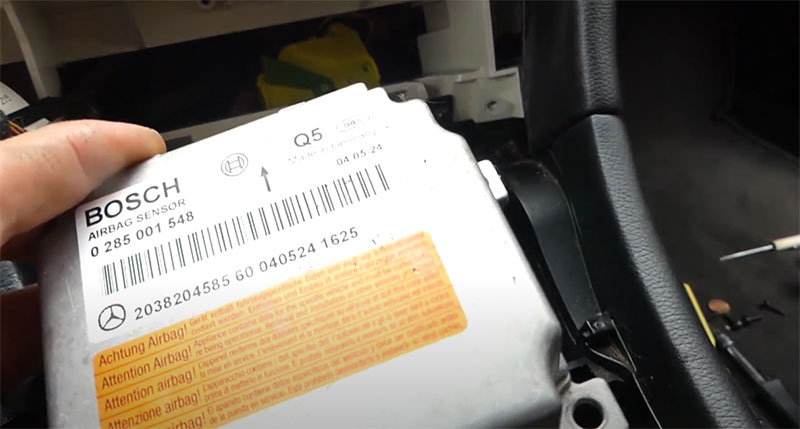
Step 4: Install the New SRS-ECU
Before installing the new SRS-ECU, double-check that the part number on the replacement unit exactly matches the part number of the original module you removed. Installing an incorrect ECU can lead to system malfunctions and safety issues.
Position the new SRS-ECU in its mounting location and secure it using the original mounting bolts or screws. Tighten them to the manufacturer’s specified torque using a torque wrench. Proper torque ensures the module is securely mounted without being over-tightened.
Carefully reconnect all the electrical connectors to the new SRS-ECU. Ensure that each connector is fully seated and the locking mechanisms are engaged.
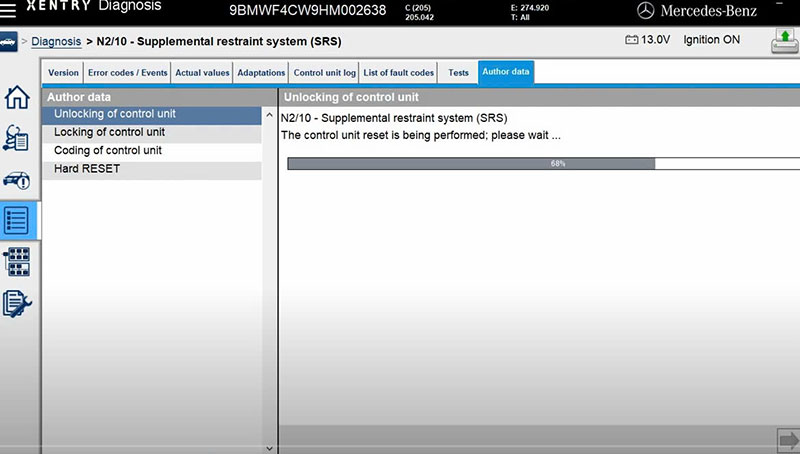
Step 5: Reconnect the Battery and Perform Initial Testing
Reconnect the negative battery cable to the negative battery terminal. Tighten the terminal clamp nut securely.
Turn the ignition key to position II (accessory mode). Observe the dashboard for the SRS warning light. If the new SRS-ECU does not require immediate programming (some pre-coded units exist), the SRS warning light should turn off after the system performs its initial self-check.
Start the engine and allow it to run for a few minutes. Continue to monitor the SRS warning light.
New SRS-ECU modules typically require programming to function correctly:
In most cases, a new SRS-ECU module will require programming and coding to integrate it correctly with your specific vehicle’s configuration. This process involves transferring vehicle-specific data to the new module.
Connect your Mercedes-compatible diagnostic scanner (MB Star C4/C5/C6 or SD Connect) to the vehicle’s OBD-II port.
Turn the ignition key to position II (accessory mode).
Using the diagnostic software, navigate to the SRS (Supplemental Restraint System) module.
Look for the programming or coding function. The exact terminology may vary depending on the software version.
Follow the on-screen prompts provided by the diagnostic scanner. You will likely be required to input vehicle-specific data such as the Vehicle Identification Number (VIN), model code, and potentially other information related to the vehicle’s options and configuration.
Initiate the programming or coding process. This typically takes between 5 to 15 minutes, during which the diagnostic tool communicates with the new SRS-ECU and uploads the necessary data. Ensure a stable power supply to the vehicle during this process.
Once the programming is complete, clear any fault codes that may have been generated during the procedure.
Perform a system test of the SRS module using the diagnostic scanner to verify that all components are communicating correctly and functioning as expected. Check if the SRS warning light on the dashboard remains off.
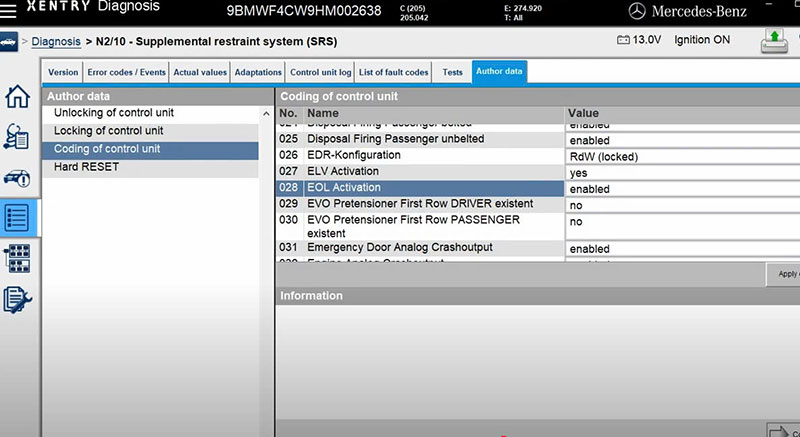
If the B1616 code reappears after replacing the SRS-ECU:
In the less common scenario where the B1616 code reappears even after replacing the SRS-ECU and performing the necessary programming, further troubleshooting is required to identify the underlying issue.
Check All SRS Wiring Harness Connections: Carefully inspect all electrical connectors related to the SRS system, including those at the SRS-ECU, the crash sensors, and the airbags. Ensure that all connectors are fully seated, properly locked, and free from any signs of damage, corrosion, or loose wiring. Refer to Mercedes wiring diagrams (WIS/ASRA) for detailed information on the SRS wiring harness.
Verify Stable Battery Voltage: An unstable or low battery voltage can sometimes cause electronic control units to malfunction or report incorrect fault codes. Use a multimeter to check the battery voltage while the engine is off and while it is running. Ensure that the charging system is functioning correctly and providing a stable voltage within the manufacturer’s specifications (typically around 12.6 volts with the engine off and 13.5 to 14.5 volts with the engine running).
Inspect Ground Connections: Poor or corroded ground connections can lead to various electrical issues. Locate all ground points related to the SRS system (these are usually bolted to the vehicle’s chassis) and ensure they are clean, tight, and free from corrosion.
Confirm Replacement SRS-ECU Specifications: Double-check that the replacement SRS-ECU you installed is indeed the correct part number for your specific Mercedes-Benz model and year. An incorrect ECU, even if it seems similar, can lead to compatibility issues and the reappearance of fault codes.
Consult a Mercedes Specialist: If you have diligently checked all the above points and the B1616 code persists, it is advisable to seek assistance from a qualified Mercedes-Benz technician or specialist. They have the advanced diagnostic tools, expertise, and access to comprehensive technical information to diagnose and resolve complex SRS issues.
While some SRS-ECU failures may be unavoidable due to internal defects or unforeseen circumstances, certain preventative maintenance measures can help minimize the risk of future issues and ensure the long-term reliability of your vehicle’s Supplemental Restraint System.
Maintain Proper Battery Voltage: Ensure your vehicle’s battery is in good condition and maintains a stable voltage. Avoid deep discharges of the battery, and if the battery is old or showing signs of weakness, replace it promptly.
Address Water Leaks Promptly: Water intrusion can cause significant damage to electronic components. If you notice any water leaks in or around the passenger cabin, especially near areas where SRS components are located (e.g., under seats, center console), address and repair these leaks immediately.
Avoid Non-Approved Electronic Accessories: Using aftermarket electronic accessories that are not specifically designed and approved for your vehicle can sometimes interfere with the proper operation of sensitive electronic modules like the SRS-ECU. Stick to approved accessories and ensure they are installed correctly.
Respond Immediately to SRS Warning Lights: Never ignore an illuminated SRS warning light or any SRS-related error messages in your instrument cluster. Address these issues promptly to prevent potential escalation and ensure the continued functionality of your safety system. Regular diagnostics can catch minor issues before they become major problems.
By adhering to these preventative maintenance tips, you can contribute to the overall health and reliability of your Mercedes-Benz’s SRS system and potentially avoid future ECU failures.
The B1616 fault code in Mercedes vehicles signals an SRS-ECU safing G-sensor failure. Resolving this issue requires proper diagnostics and, in most cases, ECU replacement. While some DIY mechanics can perform this repair, SRS repairs involve safety-critical components. If unsure, seek help from a Mercedes specialist.
If you’re still struggling with the Mercedes B1616 fault code or want to ensure the job is done right the first time, AutoExplain is here to help.
We specialize in:
ECU Coding & Programming Support – Get expert assistance for configuring or updating your control units.
Airbag & SRS Module Reset Services – Clear crash data and restore safety systems after repairs.
Remote Diagnostic Solutions – Let our experienced technicians guide you step-by-step, no matter where you are.
Whether you’re a DIYer or a professional technician, AutoExplain provides the technical support and tools you need to diagnose and repair with confidence.
👉 Contact us today for personalized guidance and expert support in resolving the B1616 code and other Mercedes fault codes.
Let AutoExplain be your go-to partner for smarter, faster, and safer repairs.
📞 Contact us via WhatsApp: +1(936)2896695

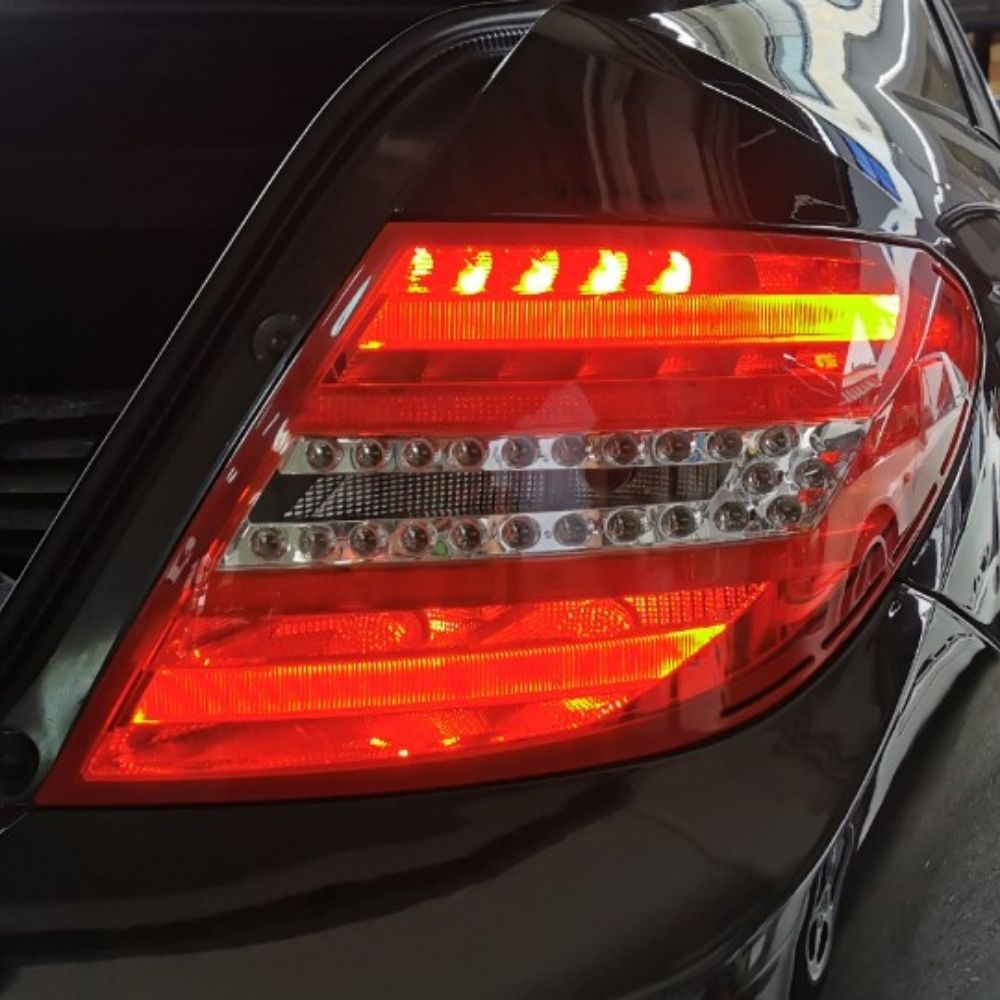
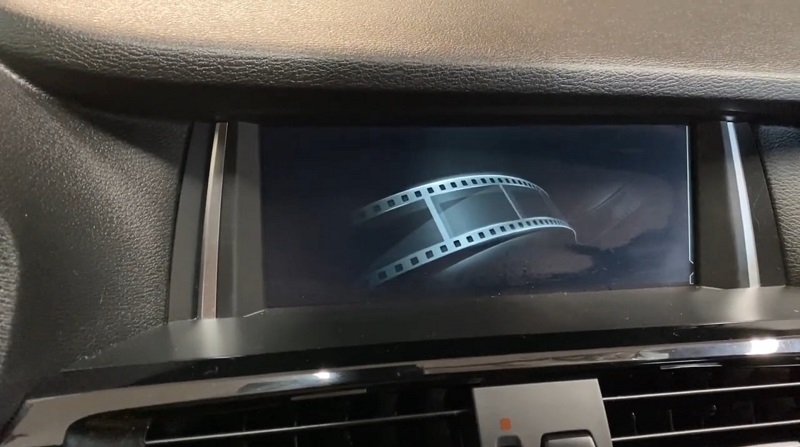
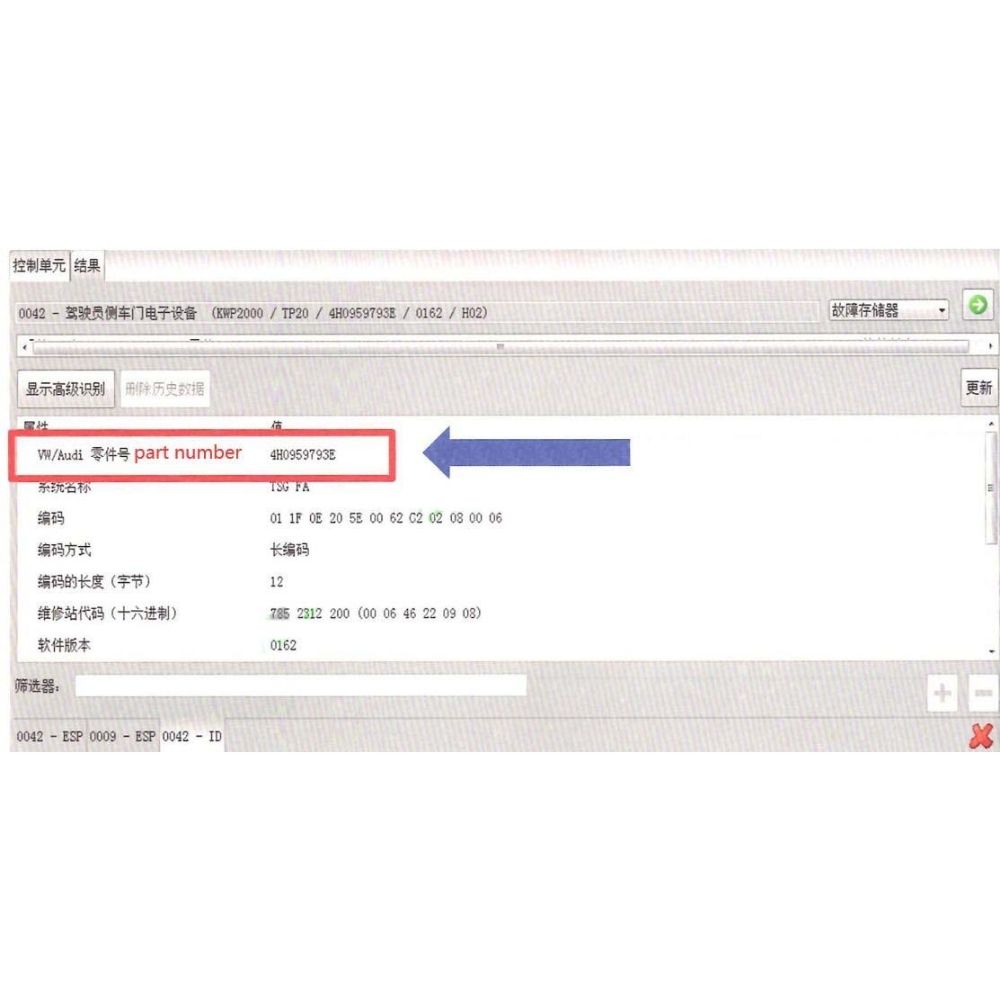

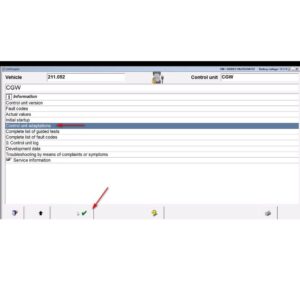
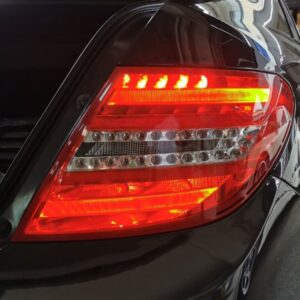
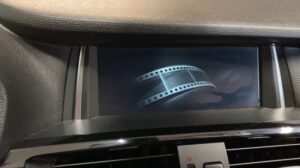
At AutoExplain, we provide automotive online repair service, auto repair tips, car repair manuals & document & training course to help mechanics of all experience levels—fix vehicles efficiently
AUTO EXPLAIN LLC
Employer Identification Number (EIN):
38-4349958
Whatsapp Us: +1(936)2896695
Gmail: [email protected]
Our Workshop: 1500 N Grant ST Sten Denver, Colorado, United States
Copyright 2025 © AutoExplain